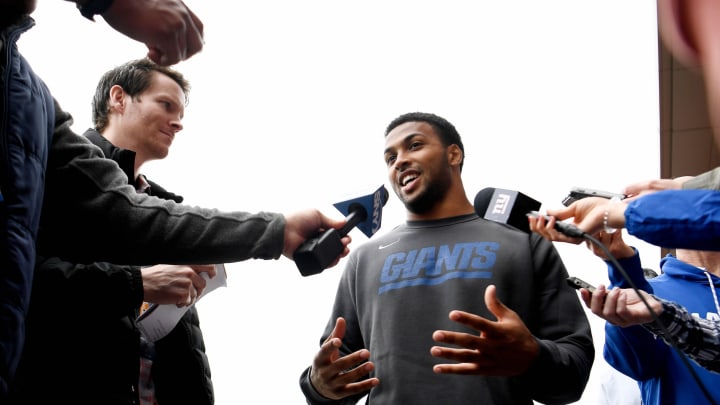Julian Love: The Good, the Great and the Ugly

Defensive back Julian Love stamped himself as a valuable commodity in his rookie 2019 season with the New York Giants.
Love, a boundary corner at the University of Notre Dame in college, made the difficult transition to safety after being drafted by Dave Gettleman.
His conversion to the other secondary position led to him finding the field on defense late. But once he saw the field, it’s easy to discern that he earned the playing time.
Starting safety Jabrill Peppers was injured in Week 12 against Chicago, which was the same game that Love started seeing significant snaps on defense. Now former defensive coordinator James Bettcher’s defense is notorious for being tough to comprehend, so it’s no surprise that it took Love a few weeks to adjust to the position change as a rookie.
As a “safety,” Love played 176 snaps in the box, 129 as a slot corner, and 77 as a free safety while adept near the line of scrimmage. His versatile nature became incredibly important to the Giants' defense, and it figures to be a fixture in the long-term plans of a three-headed "monster" that consists of Love, Jabrill Peppers, and second-round pick Xavier McKinney.
In this week’s edition of the Good, the Great, and the Ugly, we will discuss some of Love’s best traits and how he can leverage what he does best in the new system, while also focusing on some things he can improve.
The Good: Excellent Closing Burst
Love is a very good athlete with excellent acceleration. At the combine, he only ran a 4.54 40 yard dash, which isn’t bad, but there are times on Sunday where he shows a lot more speed.
The play above is against the Eagles Carson Wentz, a good athlete, albeit a quarterback. From the opposite side of the field, outside the hash, Love is able to chase down Wentz and accelerate so quickly to put himself in a position to cut the angle of Wentz off, so he picks up minimal yardage. I remember seeing this play live and thinking, “Love is that quick?” It turns out he is!
It’s also easy to notice on quick game type routes like the two we see above; the first one against Ertz is a quick out route that Love is able to close width quickly after the catch. Ertz is able to do well initially with his stem. But once Ertz cuts outside Love is already barreling down towards the tight end to ensure that he doesn’t pick up the first down.
The second clip is similar, only in the middle of the field. Love shows a really good ability to click & close downhill on the quick tight end button hook.
That acceleration to close is a vital part of disrupting passes, making sound tackles, and forcing fumbles. Love’s ability to close width fast also happens in wide-open space, which forces tough angles for the ball carriers.
Watch how Jamal Williams checks and releases into the flat with the two clearout routes to his side opening up space. There is nothing but grass ahead of Williams, but Love cuts the angle off and makes a sound tackle in space. Rookies tend not to read routes, react, and attack with the tackling form that Love displays on a lot of these plays.
Quick acceleration helps him in coverage too, especially on quick breaking routes or passes that aren’t “on a line.” Routes that are timed up well will be in-sync with the quarterback’s throw, so when the receiver breaks, the ball is already going to the receiver's destination.
Love has the ability to take advantage of receivers and quarterbacks whose timing isn’t excellent or precise because of this acceleration. Love plays inside leverage, forcing the receiver outside while keeping his hips disciplined.
The receiver attempts a push-off that fails, and Love is able to be disruptive at the catch point. The throw wasn’t perfect, but Love still put himself into an advantageous position.
The Great: Tackling Near the Box
Love proved to be keen near the line of scrimmage with exceptional skills near the box, despite his 5’11", 195-pound, frame.
He doesn’t play like he’s a liability in the box and his quick decision making, combined with his tough physical play, were some of the reasons why in six games at safety, he had 14 stops, which per PFF, is defined as a failed offensive play due to a tackle.
Opposing offenses always tried to wash Love out of the play with tight ends or tight wide receivers, but Love was always too quick and slippery to allow them to be effective.
In all three of the above plays, Love squeezes in between the block and the tackle’s hip to split the line of scrimmage and make a tackle near it while bringing that aggressive nature to the box.
Love proved to be a difficult blocking assignment, and good luck locating him if you attempt to do what the Dolphins did above. Love’s ability to key and diagnose in the box is another aspect of his game that is incredible when you think he spent his college career playing cornerback.
Reading box run keys and reacting accordingly is more of a linebacker skill, but the current NFL is so cross-trained that it also applies to other positions.
Love has proved to be a good contain/force defender on the outside, and that’s not always an easy task for a first-year player, especially one that isn’t used to be utilized in that manner. It shows a lot of maturity, mental processing, and versatility to accomplish that effectively.
We see him be strong at the tackle point and withstand cut blocks from much bigger football players in the clips above. (I would also be remiss not to mention the dominating plays from Dexter Lawrence and Dalvin Tomlinson on the interior as well in the above clips.)
The acceleration and effectiveness in the box work out for Love as a backside defender in pursuit and while blitzing.
Love squares up, stays tight to the line of scrimmage and crashes down on Boston Scott to ensure that he doesn’t gain much yardage on the rushing attempt.
In the second clip (above), Love quickly shoots the gap and makes the tackle in the backfield. Having a quick ability to start and stop is an excellent way to take advantage of poor blocking angles in protection if the blitz is disguised well enough.
The Ugly: Contested Catch Situations
I don’t fully believe that Love is poor in contested catch situations, but the small NFL sample size suggests that it wasn’t his strong suit.
He was targeted 26 times, surrendering 18 receptions with only two passes defended and the one interception (against Mitchell Trubisky of the Bears).
Love put up impressive college stats in terms of passes defended and interceptions; he had five picks and 39 passes defended in his three years for Notre Dame.
Love does a really good job sticking with the receiver on the double horizontal cross. He stays in the hip pocket and shows a lot of quality man coverage traits in the rep, but he allows the reception to happen, partly because he can’t locate the ball and disrupt the pass in the air.
I don’t believe this is a huge issue with his game, but the sample size is so small that it’s just enough to acknowledge.
I fully expect Love to improve in this next season; his skill-set is too good, and his athletic traits suggest that he really can be special. But as of now, Love hasn’t done it in the professional ranks.
Final Thoughts
Love was a productive boundary cornerback in college that made the switch to safety in his rookie season.
By the end of the year, Love made the switch look seamless and proved to be adept near the line of scrimmage in a more “linebacker” type of role.
This is a precursor to the Patrick Graham implementation of Love, Peppers, and McKinney, three defenders that the Giants can use in a versatile manner, in many different roles, in the 2020 season.
I fully expect Love to rectify the very short amount of completions he allowed in contested situations. I believe he has an incredibly important role in the future of Graham’s defense.
He’s effective in man coverage, can play deep, in the box, as a corner, in the slot, or as a blitzer. I’m excited about his future. And if you’re a Giants’ fan, you should be too.
